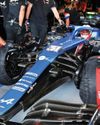
As the motoring world starts to home in on solutions to what will fuel our transport needs in the future, Toyota has opted to create a hydrogen-powered Corolla Sport, which was given its public competition debut by Rookie Racing in the Super Taiku 24-hour race at Fuji at the end of May.
The car, powered by an internal combustion engine using hydrogen fuel, was driven by the company owner, Akiyo Toyoda, whose plan it was to prove the fuel is safe and that, contrary to popular belief in Japan, he would not be blown up in the process.
Fuel cell electrified vehicles, such as Toyota’s Mirai, use a fuel cell in which hydrogen chemically reacts with oxygen in the air to produce electricity that powers an electric motor. Hydrogen engines generate power through the combustion of hydrogen using fuel supply and injection systems modified from those used in petrol engines.
Combustion in hydrogen engines occurs at a faster rate than petrol engines – Toyota has calculated it at eight times faster. While this will reduce stint times in a racecar environment, despite using compressed hydrogen in the fuel cell, it means there is power available even from low down the rev range, giving excellent throttle response.
Hidden potential
The plan is that the car, which uses the four-wheel-drive system developed in the GR Yaris and is powered by a 1.7-litre, three-cylinder, in-line turbo engine with an intercooler, will be fuelled during races using hydrogen produced at the Fukushima Hydrogen Energy Research Field. Although CO2 emissions are lower than a standard fossil fuel engine, they are not zero as small amounts of engine oil are burnt during the combustion process, creating NOx emissions at the tailpipe.
This story is from the July 2021 edition of Racecar Engineering.
Start your 7-day Magzter GOLD free trial to access thousands of curated premium stories, and 8,500+ magazines and newspapers.
Already a subscriber ? Sign In
This story is from the July 2021 edition of Racecar Engineering.
Start your 7-day Magzter GOLD free trial to access thousands of curated premium stories, and 8,500+ magazines and newspapers.
Already a subscriber? Sign In
Talk the torque
More thoughts on in-wheel motors and their effects on twisting force
Rolling about
An explanation of the limitations of a previous load transfer article, bringing jacking forces into the mix
F1 breaks schedule records
The FIA has confirmed no fewer than 23 races on the 2022 Formula 1 World Championship schedule, the highest number of grands prix ever to be held in a single season, and that has led to criticism from some teams that will be on the road for eight months.

Under pressure
Toyota may have finished first and second at Le Mans this year, but the effort required to overcome a fuel delivery problem and finish with both cars was Herculean
Physics at work
Dutch company, Intrax, offers Racecar Engineering an insight into the technologies it employs to optimise its suspension products
Williams' 2030 ambition
Williams Racing has committed to becoming climate positive by 2030 as part of an all-new sustainability strategy.
Diff'rent strokes
Racecar looks at the different types of mechanical differential, their benefits and limitations
Das Boot
A curious Twitter exchange fired up a unique, hydrogen-powered, cross-country project that will contest the Baja 1000 in November 2022

Air born
Every racecar engineer's dream is a blank sheet of paper design. When Hoonigan and Subaru approached Vermont Sportscars about building the next generation of Gymkhana racer, that's just what the company was given

Remote control
Called variously ‘virtual garages’, ‘mission control’ or ‘race support rooms’ is the future of race engineering sitting in the warm back at HQ?